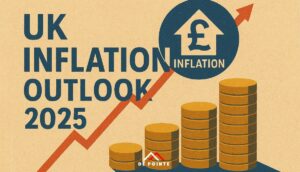Article

Traditional investors in the FTSE 100 have endured a challenging period marked by sharp swings and disappointing drawdowns. After the index reached an all-time closing high of 8,871.31 on 3 March 2025, it plunged 4.9% just a month later on 4 April—its steepest one-day drop since March 2020—erasing significant gains and rattling even the most seasoned blue-chip holders. This roller-coaster has left many long-only portfolios underwater, prompting investors to reassess whether a 100% allocation to large-cap UK equities still makes sense in an increasingly uncertain environment.
Market Snapshot
- As of the close on Friday, 23 May 2025: 8,799.56, up 0.94% on the day.
- Year-to-date performance: +7.8% since 1 January 2025.
- 12-month return: +5.9% over the past year.
While these headline figures imply modest gains, they belie the underlying volatility: multi-day drawdowns of over 4% in April and whipsaw reversals have tested investor conviction and liquidity buffers alike.
Macro Backdrop
- Inflation pressures: The Consumer Prices Index rose to 3.5% in April 2025—the highest since January 2024—driven by elevated energy, transport, and housing costs.
- Monetary policy: The Bank of England trimmed its Bank Rate by 25 bps to 4.25% on 8 May, acknowledging disinflationary trends but warning against premature easing amid sticky core prices.
- Trade tensions: Renewed Brexit-era frictions and the spectre of U.S. tariffs on EU goods introduced episodic spikes in market volatility, most recently calmed by a Trump administration delay of 50% levies until July.
These forces have combined to create a choppy trading environment that amplifies the downside when sentiment sours.
Composition & Concentration Risks
Despite comprising 100 companies, the FTSE 100 is highly concentrated:
- Top sectors (March 2025): Banks, Healthcare, Industrial Goods & Services, and Energy collectively account for roughly 50% of the total market capitalisation.
- Key constituents: Four companies—AstraZeneca, Shell, HSBC, and Unilever—each boast market caps above £100 billion and collectively represent about 29% of the index.
This concentration means that idiosyncratic shocks to a handful of names—whether regulatory setbacks for banks, R&D delays in pharmaceuticals, or swings in oil prices—can disproportionately sway the entire index.
The Pain of Volatility
For many traditional investors, the past quarter has underscored several harsh realities:
- Significant drawdowns: After the March record highs, the FTSE 100 plunged 4.9% on 4 April and closed down for a second consecutive day, marking its biggest back-to-back slump since the onset of the COVID-19 crisis.
- Whipsaw reversals: Gains of 1–2% have frequently been offset by sharp declines of similar magnitude within days, leading to “flat” year-to-date returns once transaction costs and taxes are factored in.
- Concentration risk: A handful of underperformers—particularly in the Energy and Financial sectors—have dragged the broader index lower despite pockets of strength in Miners and Healthcare.
These experiences have left portfolios vulnerable to sudden liquidity demands and forced rebalancing at inopportune times.
Why Consider Alternative Investments?
To soften the blows inflicted by FTSE 100 volatility and to seek improved risk-adjusted returns, many investors are now turning to alternative investments. These can offer:
- Lower correlation to public equities, smoothing overall portfolio swings.
- Diverse return streams, including private equity buyouts, real estate rental income, and infrastructure concessions.
- Enhanced income potential through private credit or direct lending strategies, which often yield higher coupons than government or corporate bonds.
- Inflation protection, as real assets—like property, commodities, and infrastructure—often feature contractual escalators tied to CPI.
- Access to niche opportunities, such as venture capital in high-growth technology start-ups or hedge fund strategies designed to profit in both rising and falling markets.
By allocating even a modest portion (e.g., 10–20%) of a traditional equity portfolio to alternatives, investors can dampen the peaks and troughs of a pure FTSE 100 allocation, preserving upside while cushioning downside.
Practical Steps to Diversify
- Assess your liquidity needs: Alternatives can be less liquid than FTSE 100 shares; tailor allocation size to match your cash flow requirements.
- Choose the right vehicles: Pooled funds, listed infrastructure trusts, and regulated private credit vehicles each offer different liquidity profiles and fee structures.
- Consider hybrid approaches: Multi-asset funds that blend public equities, bonds, and alternatives simplify the implementation of a diversified strategy.
- Monitor correlation dynamics: Track rolling correlations between your FTSE 100 holdings and alternative positions to ensure they deliver the intended diversification.
At De Pointe Research, we specialise in bespoke, multi-asset solutions that integrate alternative investments seamlessly alongside FTSE 100 exposure. Don’t let last quarter’s volatility decide your future returns—discover how a thoughtfully diversified portfolio can protect your wealth and capture new opportunities.





